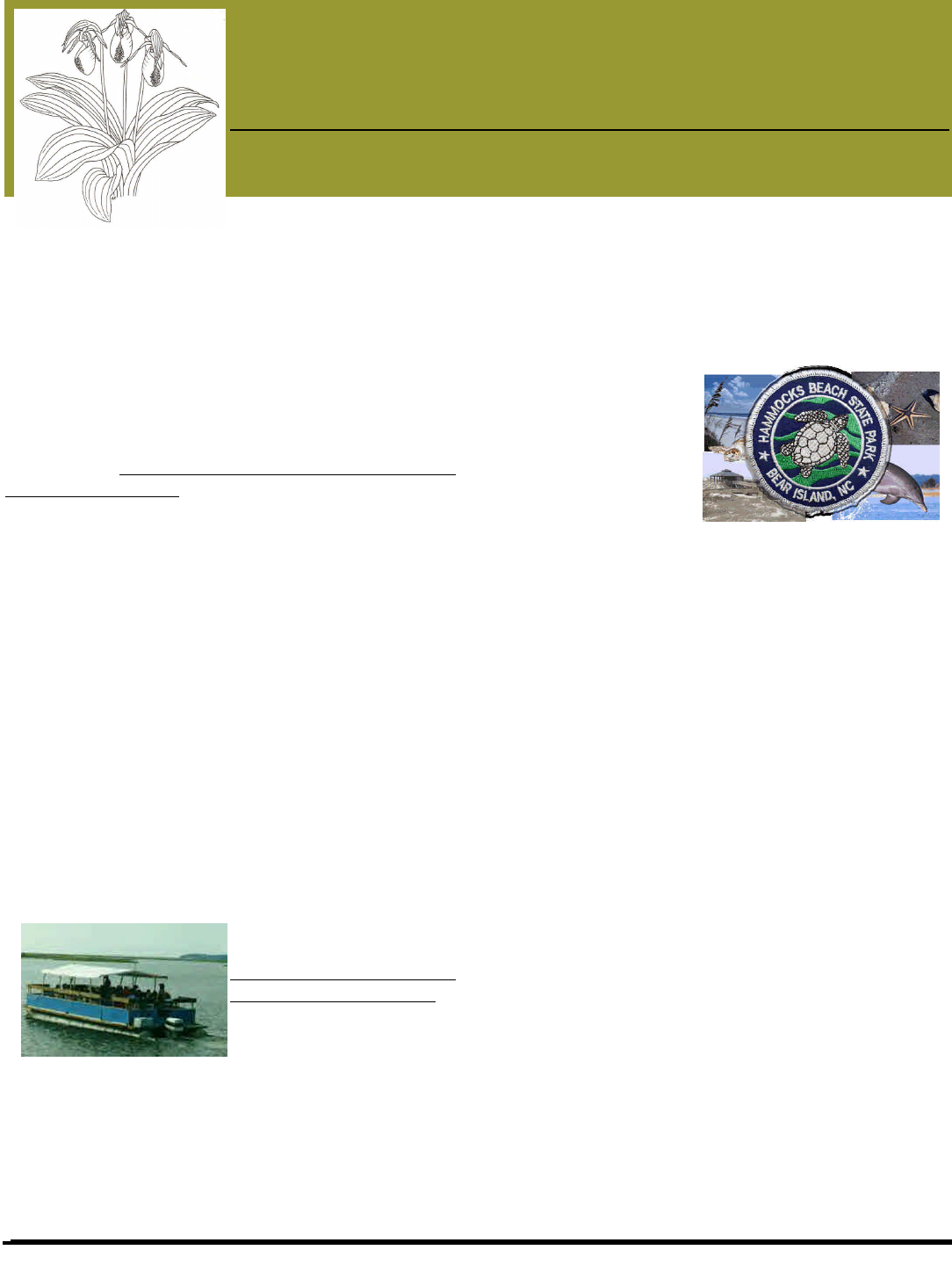
Page
1
Native Plant News
September/October 2006
Native Plant News
The Newsletter of the North Carolina Native Plant Society
Volume IV, Issue 4
Sept/Oct 2006
W
hat to bring:
LUNCH
,
WATER
, snacks, sunscreen/hat,
sturdy walking shoes, insect repellent, field guides,
binoculars, rain jacket, walkie
-
talkies if you have them and
enthusiasm!
D
ON
’
T
FORGET
YOUR
LUNCH
AND
WATER
FOR
S
ATURDAY
AND
S
UNDAY
.
Friday, October 6, 2006:
Arrive at Emerald Isle, NC
5:00
–
7:30
-
Dinner on your own
7:30
–
9:00
–
Meet & Greet at Islander Mo
tor Inn, in and
around Alice’s Oceanside room near the pool.
Saturday, October 7, 2006:
8:30 am
–
meet at Islander Motor Inn
9:
00
--
4:30
–
Boat tour of salt marshes around Bear Island
and Huggins Island and botanize on Bear Island
6:00
–
7:00
–
Dinner on
your own, Emerald Isle area
7:30
–
8:30
–
Presentation and Discussion, Islander Motor
Inn meeting room
Sunday, October 8, 2006
:
8:30 am
–
meet at Islander Motor Inn
9:00
–
3:00
–
Botanize at long leaf pine savannas in Croatan
National Forest
3:00
-
Depa
rt for home
Bear Island and Huggins
Island, Saturday 8:30 am
Bring lunch and water
!
Led by Sam Bland, Natural
Resources Ran
ger, Hammocks Beach State Park and Dale
Suiter, botanist, US Fish & Wildlife Service. Charge: $10 per
person for the boat tour a
nd transportation to and from Bear
Island. Because of the size of the boat, this portion of the
trip will be limited to the fir
st 28 people that sign up*.
NCNPS Fall Trip
Hammocks Beach and Croatan National Forest
October 6
–
8. 2006
Natural Resource Ranger
Sam Bland will take us on
a boat tour of the salt
marshes around Bear
Island and Huggins Island
and the
n we will explore
the flora of Bear Island as
we stroll from the marsh side of the island to the oceanfront.
Hammocks Beach Stat
e Park is located on Bear Island, an
892
-
acre barrier island. The island, 3.5 miles long and less
than a mile wide, is bordered
by the Atlantic Ocean to the
south and by salt marshes, estuarine creeks and the
Intracoastal Waterway to the north. Bogue Inlet
lies at the
northeast end of the island; Bear Inlet lies to the southwest.
Shrub thickets and maritime forests create a wilder
ness
environment. Large dunes and sand ridges dominate the
landscape. Migrating sand, carried by the wind, often buries
portion
s of the maritime forest. Tall dunes vegetated by sea
oats, American beachgrass and seaside goldenrod dominate
most of the isla
nd. At the northeast end of the island is a
maritime forest populated by loblolly pine, red cedar, red
maple, red bay and vario
us oaks. The northwest portion of
the island is primarily marsh, dominated by cordgrass and
black needle rush. Hammocks Beach i
s also a favored
nesting place for loggerhead sea turtles. Female
loggerheads come ashore at night to nest above the high
-
tide
line between mid May and late August. Hammocks Beach is
also a haven for migratory shore birds that feed in tidal
marshes and r
est on the beach in the spring and fall.
Our tour will end at the ocean. Participants will be able to
leave as soon as we fini
sh the walk across the island, or they
can stay and spend the afternoon on the beach. Ferries
depart the island for the mainlan
d every hour on the hour
until 5:00 PM.

Page
2
Native Plant News
*If more than 28 people sign up, Jeannie Kraus will lead a
second group that will take the 9:30 ferry to Hammocks
Beach . The 2
.5 mile ferry ride takes about 25 minutes and
offers a glimpse of interesting wetland inhabitants, including
herons and egrets.
After travelling through the Intracoastal
Waterway, the ferry moves through the shallow waters of Cow
Channel, then docks at th
e pier on Bear Island where a half
-
mile trail travels through the dune system, across the island, to
the beach.
Exploring on yo
ur own:
Between Bear Island and the Islander Motor Inn, you will pass
close by the Cedar Point Tideland Trail. This easy 1.3
-
mi
le loop
trail includes 6 boardwalk bridges that take you into the heart
of an estuarine environment without fear of trampling fr
agile
species or getting your feet wet! Get an up close look at a salt
marsh and tidal creek, and enjoy a nice view of the mile
-
and
-
a
-
half
-
wide expanse of the White Oak River. Interpretive signs
tell the story of this community and how it is constantly
changing. The short loop is level and wide enough for
wheelchairs. Benches along the way provide rest stops.
Directions: From N
.C. 24 go north on N.C. 58 for 1.25 miles
and turn left on VFW Road. The turn into Cedar Point
Recreation area is 0.5 miles, on
the left. Trailhead parking is
0.7 miles. Downloadable map available at: www.cs.unca.edu/
nfsnc/recreation/cedar_point.pdf
Dinn
er on your own in the Emerald Isle area, Saturday
6:00 pm
There are at least 6 restaurants nearby; two of which are
seafood rest
aurants. You may wish to go to the Seafood
Festival at Morehead City for dinner.
Portifino's Italian
is near
the Islander Motor
Inn and
Jordan's Seafood
is about 2 miles
away.
Bushwhacker's Seafood
at the Emerald Isle Pier opens
at 5 PM.
Rucker John's
an
d
Cello's
are located at Emerald
Plantation.
Presentations and Discussion, Saturday evening, 7:30
pm
Islander Motor Inn meeting
room. Speaker: Jeannie Krauss, NC
NPS member and Curator of Science at the NC Maritime
Museum. Jeannie will give a slide prese
ntation about local
wildflowers, including some things we may see on the Sunday
field trip.
Croatan National Forest Longleaf Pi
ne Savannas,
Sunday 8:30 am
Bring lunch and water!
Led by John Fussell, local naturalist, and Misty Franklin,
botanist with t
he NC Natural Heritage Program.
Tour some of the renowned Longleaf Pine Savannas at the
Croatan National Forest. Selection of
field trip location will be
partly based on which areas have been burned during the past
year, to find the greatest diversity o
f flowering herbs and
grasses. Sites will include the nationally significant Millis Road
Savannas and Pocosins and the Little Road Longleaf Pine
Savannas. We can expect to see many rare and interesting
plant species such as Venus flytrap (
Dionaea muscipula
),
pitcher pla
nts (
Sarracenia spp.
), sundews (
Drosera spp.),
rough
-
leaf loosestrife (
Lysimachia asperulifolia
), scale
-
leaf
gerardia (
Agalinis
aphylla
), blazing stars (
Liatris spp.
), pine
-
barren gentian (
Gentiana autumnalis
) and,
–
if we’re lucky
-
yellow fringeless orch
id (
Platanthera integra
). Expect stunning
views of fruiting wiregrass in open savannas, and see the
variation in longleaf pine
communities, from dry sand ridges on
relictual dunes to lush, wet
-
loamy flatwoods grading into
pocosin.
Directions to Emerald
Isle
on the west end of Bogue Banks
on NC 58 near the Bridge at Cape Carteret, near Jacksonville
and Swansboro.
(
A
VOID
M
OREHEAD
C
ITY
THIS
WEEKEND
OF
THE
20
TH
NC
S
EAFOOD
F
ESTIVAL
)
From Triangle area take US 70 toward New Bern and
Morehead City but do NOT go
all the way to the coast on US 70.
Instead in Kinston on the US 70 bypass, take NC 58 about 40
miles toward Bogue Banks.
When
you get to Cape Carteret on
NC 58 you will cross the bridge over the sound onto Bogue
Banks.
The Islander Motor Inn is the se
cond right after you cross the
bridge.
Motel Accommodations in the Emerald Isle Area:
Islander Motor Inn
, 102 Islander Drive,
Emerald Isle, NC, 1
-
800
-
354
-
3464
We will convene each morning and meet for Saturday evening
presentation here.
$75 + tax for
side rooms, $85 + tax ocean side
Block of rooms reserved until September 15
www.islandernc.com
No
continental Breakfast availa
ble at Islander Motor Inn.
Rooms include microwave and small refrigerator.
Nearest restaurant is Mike’s Place 2 miles from motel
. 252
-
354
-
5277
Bogue Inlet Motel
252
-
354
-
3406, 120 Bogue Inlet Drive, $55 + tax sound
side
Rusty Pelican Inn
252
-
354
-
3450, 810
4 Emerald Drive, $55 + tax, 2 blocks
from ocean
Campgrounds nearby
:
Holiday Trav
-
L
-
Park Resort for Campers
252
-
354
-
2250 $25 per
night
per tent
9102 Coast Guard Road (first right after the bridge, next door to the Islander
Motel)
(Atlantic Beach is about
20 miles away with many more hotels, but close to
Morehead City which will be busy with the 20
th
Annual NC Seafood Festival)

Page
3
Native Plant News
September/October 2006
Registration Form: October 6
-
8, 2006
Hammocks Beach and Croatan National Forest
Name (s)____________________________________
________________________
Address: ____________________________________________________________
____________
________________________________________________
Email: ______________________________________________________________
Telephone: _________________________________________________________
Field trip registration and travel fees:
Registration fee: NCNPS members $15.00 ($8.00 limited income)
$__________
Registration fee: non NCNPS member
$25.00
$__________
Boat trip to islands (required for Saturday field trip) $10.00
$__________
Extra options:
Individual
NC NPS 1
-
year membership: $25.00 ($15.00 limited income)
$__________
For additional membership options and fee s
chedule visit www.ncwildflower.org.
NCNPS T
-
Shirt $15.00
$__________
Circle Size: S, M, L, XL, XXL
Circle Color: Cra
nberry, Green, Pink, Tan, Yellow , Lt. Blue. Lilac
Total Enclosed:
$__________
Registration deadline: September 25,
2006
Please make checks payable to
NC Native Plant Society
and mail to:
Hugh Partridge, Treasurer
736 Linda Court
Cary, NC 2751
3
Information to be completed by new members,:
I do
not
want my contact information printed in the membership directory.
I am willing to receive the newsletter via email in order to conserve resources
Member Interests: (check all that apply)
Local chapter (existing chapters in Charlotte, Triad, Triangle & NE Coastal)
Volunteer opportunities (list interests _______
___________________)
W
EATHER
W
ARNING
: I
N
THE
EVENT
OF
BAD
WEATHER
(
OF
THE
H
URRICANE
VARIETY
),
WE
WILL
CALL
OR
EMAIL
YOU
. Y
OU
CAN
ALSO
CHECK
WITH
D
ALE
S
UITER
BY
CALLING
919
-
810
-
6339.

Page
4
Native Plant News
Remembering Rob Gardner
May 6, 1949
–
August 6, 2006
At NCBG, Rob helped build
one of the best collections of
pitcher plants in the Southeast
R
ob Gardner, known to many plant enthusiasts for his
work as one of the founding curators at NC Botanical
Garden, passed away on August 6, 2006 in Chapel Hill.
After joining NCBG in 1974, Rob became a leader in the
native plant movement, constantly developing new
collections at NCBG and refining propagation methods that
have made it easier for the gardening public to enjoy the
joys of native plants. Rob was a contributing author to the
native plant propagation book
Growing and Propagating
Wildflowers
, published in 1985 by UNC Press, and he wrote
dozens of articles in popular magazines such as
Fine Gardening
,
Carolina Gardener
, and
Organic
Gardening
.
Rob’s rich legacy can be seen throughout the NC
Botanical Garden, where he developed and
maintained the Carnivorous Plant Collec
tion, the
Garden of Flowering Plant Families, the Native
Perennial Border, and the Piedmont Nature Trails.
In addition to flowe
rs, Rob loved to plant art
throughout the garden in ways that continue to
surprise and delight visitors of all ages. He also
played a key role in developing the conservation
programs at the Garden, including facilitating the
Garden’s charter membership
in the Center for
Plant Conservation, developing propagation
protocols for many rare and endangered plants,
and working with the
Garden’s nature preserves.
Rob touched so many lives through his passion for
plants and conservation. Perhaps some of the most
important contributions he made were in reminding us to
have fun with gardening and challenging us to find new
ways to be creat
ive in designing gardens that highlight not
just the plants, but the environment and the people who
enjoy them.
In lieu of flowe
rs, memorials may be made to the Nature
Conservancy, attn: Treasurer, 4245 N. Fairfax Dr., Suite
100, Arlington VA 22203, or to
the Haw River Assembly, P.
O. Box 187, Bynum NC 27228.
Entrance to Garden of Flowering Plant Families at NCBG, designed by Rob Gardner

Page
5
Native Plant News
September/October 2006
CALLING ALL NATIVE PLANT PICTURES
Please take a look at the "Plants" section of our web site
http://www.ncwildflower.org/plant
s/plants.htm
The goal for this section is to have pictures of NC native
plants from all four seasons and any distinguishing fea
ture
(s). We would like this to become a visual reference for
anyone trying to ID a native plant. We would like to have the
botan
ical name, a common name and accompanying
comments about when & where the pic was taken. We will
allow anyone to use these pics
if they credit the NCNPS
A small number of pics can be emailed to tom@ncwildflower.
org but if you have a large number, it would
be best to send a
CD to:
Tom Harville
104 Birklands Drive
Cary, NC 27511
V
INEGAR
VS
. W
EEDS
To The Editor,
I’ve learned fr
om my brother to use a white vinegar and dish
detergent spray on weeds. He keeps weeds out of his gravel
drive and grass with th
is simple nontoxic solution. I bought a
one gallon sprayer, the cheapest dish detergent from Dollar
Tree and the cheapest white
vinegar I could find. Since we
don’t have an official formula we still don’t know exactly how
much detergent is needed to keep t
he vinegar sticking to the
plants. Currently I’m trying about 12 ounces. This spray does
kill what it hits so one has to be care
ful. Japanese Stilt Grass
is brown the next day and brown spots appear in the grass
the next day wherever weeds were sprayed. A
delightful
book,
Slug Bread & Beheaded Thistles
by Ellen Sandbeck,
that has lots of nontoxic housekeeping and gardening ideas
recommends vinegar sprayed or poured on weeds in
sidewalk cracks on a sunny day to kill weeds.
Sue Cole
Triad Chapter member
TOUR LEADER OPPORTUN
ITY
The North American Rock Garden Society will host their
annual meeting in Canaan Valley Resort State Par
k, Davis
West Virginia, June 14
-
17, 2007.
They are looking for volunteer hike leaders who are
knowledgeable native plant folk.
If you are interested, please
contact Mike Slater, [email protected].
R
EQUEST
!
I am looking for pictures and descriptions of how
members have used native plants in landscaping. I will
use thes
e for displays and presentations. I can scan
pictures and slides so you can send me pictures via
regular mail or jpg’s by email
. If you send a picture by
email, I want the full size/pixels of the picture. If this is a
problem, you can send me a CD. I w
ill return any pictures
that you send.
I need a picture with a description, such as, “I
combined native coneflowers with …” or
“I used such and
such as a ground cover…” If you only have a descriptions
and no picture, send me the description. Please, on
ly
pictures with descriptions.
I will compile this and we will put it on the web. I
will use some of the pictures on displays
for the NC NPS or
in PowerPoint presentations. I will credit each contributor.
Thanks! Show off your gardens!
Jean Woods
14424 Harbor Estate Road
Charlotte, NC 28278
704
-
588
-
8313
V
ISIT
YOUR
NCNPS
WEBSITE
FOR
UPDATE
S
WWW
.
NCWILDFLOWER
.
ORG
Members news…..
Native Plant Symposium 2007
“Plants without Borders”
May 4
-
7, 2007
Presented jointly by
South Carolina Native Plant Society
No
rth Carolina Native Plant Society
Culture & Heritage Museums, Museum of York County
Watch for details
To volunteer, contact Je
an Woods

Page
6
Native Plant News
Photos from Cullowhee 2006
The NCNPS delegation at Cullowhee 2006. Missing from
the photo are George and Judy Lockhart. Are there others
that we missed?
Ken Moore, left, and Dan Patillo, right sit with Maxilla
Evans as she received the Tom Dodd Jr. Plantsman of the
Year Award at t
he 2006 Cullowhee Conference.
Plan Now
for
Cullowhee 2007
July 18
–
21
Schedule
Sunday, September 17th
New River Park Trail
8:00
–
4:00
Monday, October 16th
The Source and Function of
7:00
–
8:30
Fragrance
Kernersville library
Sunday, November 9th
Lake MacIntosh Trail
9:00
–
12:00
Monday, Novemb
er 13th Plant Study TBA
7:00
–
8:30
Kernersville library
The Chapter is considering changes to meeting
dates, so check wi
th Kathy to confirm. Call or email
for directions (336
-
855
-
8022)
October 7, 2006 9:30 AM Natura
l History of the
Piedmont Prairies and tour led by Parks and Rec of
Mecklenburg County
. Learn about the piedmont prairies
and s
ee the Schweintz's sunflower and possibly Georgia
Aster, both federally endangered plants. We will meet at
the Nature Center at
Latta Plantation.
There will be a fee of $1.50 per person.
Email Jean if you are interested in going.
Jean@ncwildflowe
r.org
Triad Chapter
(Greensboro/Winston
-
Salem/High Point
and surrounding areas)
Piedmont Chapter (Charlotte and
surrounding area)

Page
7
Native Plant News
September/October 2006
I would like to extend a special thanks to Dale Batchelor
for giving a talk on native plants to a newly formed garden
club on Au
gust 17. Dale offers garden design services
through her company Garden Goddesses (http://www.
gardengoddessesllc.com/). She is a
lso a volunteer Habitat
Steward with the National Wildlife Federation and as part
of that mission she encourage gardeners to use
natives
because of their benefit to wildlife.
It would be wonderful if all our members who have
developed a native plant talk
would consider adding add
their names to the new Speaker’s Bureau on the NCNPS
web site.
Upcoming Events
Sunday, September 17
:
Joint event with the B. W. Wells
Association. The Margaret Reid Chapter has been invited
for lunch and an afternoon of activiti
es at the B.W. Wells
Park (Rock Cliff Farm) on Falls Lake. These activities will
include nature walks, a tour of B. W. Wells’ ar
t studio,
canoe rides, and remembrances of Maud and B. W. Wells.
Falls Lake park ranger, Brian Bockhahn, will be leading
some of
the tours. Known as North Carolina’s first plant
ecologist, B. W. Wells believed that man should live in
harmony with nature an
d was an inspiration to Margaret
Reid who created a garden of wild plants at her home in
Raleigh and is our chapter’s namesake.
A member of the
B.W. Wells Association has kindly donated the lunch which
will be from 1
–
2:00 pm.
Please notify me if you plan
to attend, as we will need a head count for lunch.
Directions:
From Raleigh and Cary: Take Creedmore Road (NC50)
north to NC
98 in Wake Forest. Go east (right) about 5
miles to Stony Hill Road and take a left. Go 2 miles to big
intersection with Stony H
ills Baptist Church and go left on
Bud Morris Road. Go 2 short blocks and go left on Bent
Road. Follow that road to the end to r
each the Park.
Address: 2201 Bent Road, Wake Forest, 27587.
From Chapel Hill and Durham:
Traveling east on I
-
40
toward Raleigh,
turn north on I
-
540 (the outer loop). Travel
north on 1
-
540. Exit at NC 50 and go north. Follow
remaining directions above.
Sunday, October 1:
Visit to Cure Nursery in Pittsboro.
NCNPS members Jennifer and Bill Cure will show us the
many native woody
plants they grow primarily for stream
restoration projects. The Cure’s will answer questions
about the plants including their cultivation and
identification. Meet at 1:00 pm at the Reid Garden, Raleigh
or at the nursery a
round 1:45
–
2:00 pm.
Directions
From Raleigh and Cary: Take NC64 west toward Pittsboro.
After Lake Jordan, but before you cros
s the Haw River, take
a right at a light onto Mount Gilead Church Road (Citgo and
Boat storage on the corner. Road sign not obvi
ous.) Go left
on Sugar Lake Road. Keep going (pass a Redbud sign) and
fork right on Buteo Road. The Cure Nursery is on the right
at the end. You will see deer fencing surrounding the
nursery.
From Chapel Hill and Durham: Take 15
-
501 to Pittsboro.
Go east
on NC64. Turn left on Mt Gilead Church Road
(Citgo and Boat storage on the corner. Road sign not
obvious.) Go left on Sugar Lake
Road. Keep going (pass a
Redbud sign) and fork right on Buteo Road. The Cure
Nursery is on the right at the end. You will see d
eer fencing
surrounding the nursery.
Margaret Partridge
Margaret Reid (Triangle) Chapter Chair
919
-
467
-
2727
Margaret@ncwildfl
ower.org
Check NCNPS website for updates on
chapter activities:
www.ncwildflower.org
Margaret Reid Chapter (Raleigh, Durham, Chapel Hill and surrounding areas)
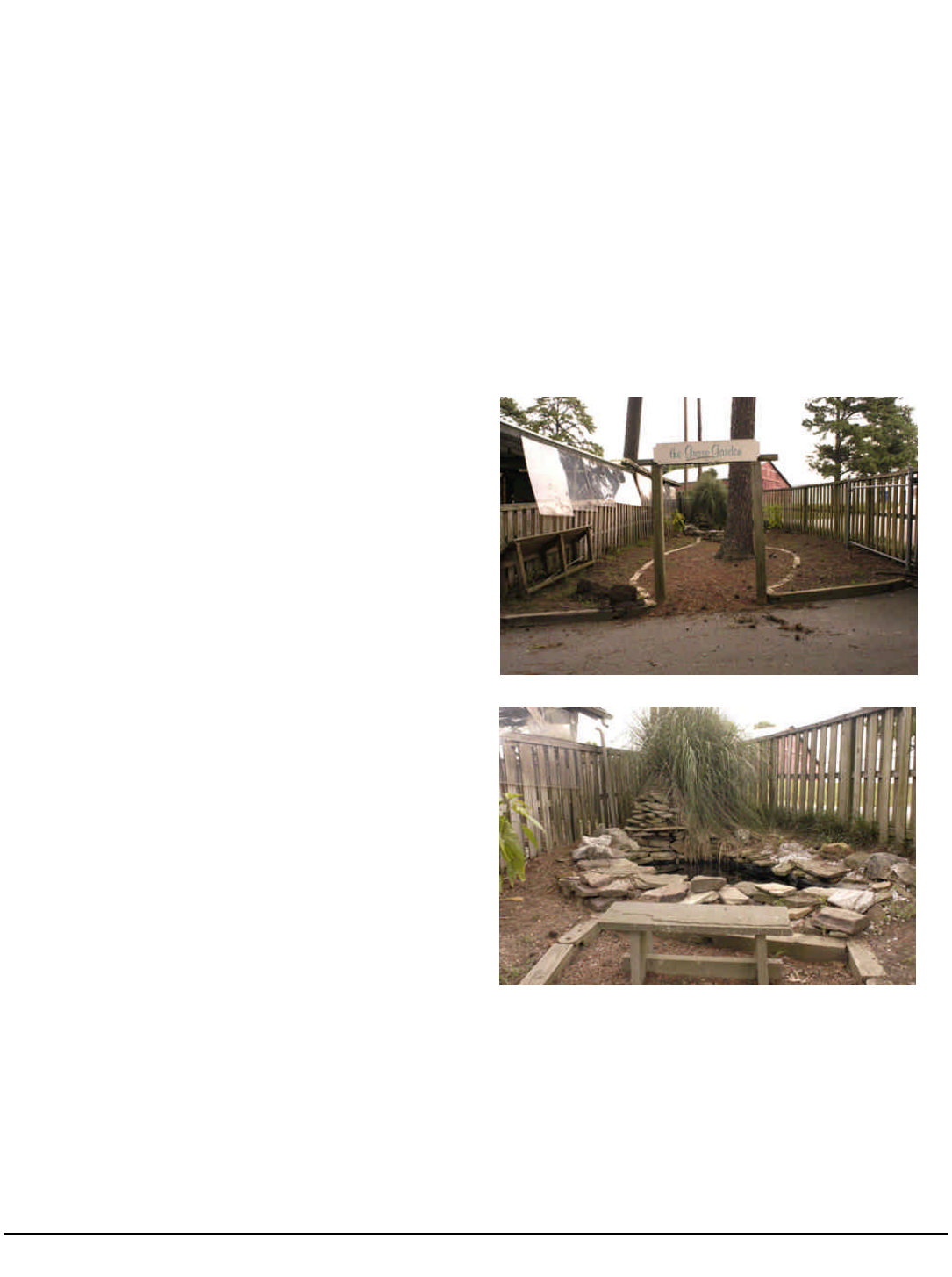
Page
8
Native Plant News
T
he NCNPS has agreed to create and maintain a
native plant garden within the Flower Show area at the
State Fairgrounds. Unlike the competition gardens and
most other exhibits, we plan to plant in the ground and
make this a permanent display of North Carolina native
plants. At the present time the
Native Plant Garden
will be
on view only during the ten days of the State Fair in October,
but as there are plans to use the Flower Show area for
wedding and parties, our garden will eventually be seen at
other times of the year too. The area we have to work with
is approximately 24 by 50 feet and has a pond at one end.
The Flower Show displays are primarily aimed at gardeners
and we would like to acquaint them with an aesthetic that is
both beautiful and ecologically sound: one that includes
available natives that work well in the garden, that
treasures and nurtures the common natives that might be
already present in people’s yards, and that discourages the
use of invasive exotics. Each year we can vary the display
by using different herbaceous plants or even photographs
to emphasize a different native plant topic.
We are in need of volunteers who can provide the labor to
plant the garden and remake the water feature. Margaret
and Hugh Part
ridge, Tom Harville, and Stefan Bloodworth
have already spent a combined total of about 12 hours
assessing the site, draining an
d cleaning the pond, and
removing weeds. We will be sending out e
-
mail notices of
workdays soon.
Stefan Bloodworth, Curator of
the Bloomquist Native
Garden at Duke University, has kindly agreed to design the
planting of the garden and the remake of the wa
ter feature
and is providing much of the woody plant material. We will
focus on a wildlife planting this year and include plants
such as our native viburnums, shrub dogwoods and
hawthorns.
We also will need volunteers who would be willing to
answer quest
ions and man our display during the Fair
October 13
–
22. Although we are not required to man the
garden, we feel that Fair goer
s would learn much more if
there were NCNPS members available to answer questions
and explain the use of native plants. Fair vol
unteers will be
allowed to park within the Fair grounds and will receive a
complimentary ticket to the Fair. Maybe you and your
family, or friends, are planning to go already? You could
bring them to the Fair, volunteer for a couple of hours, and
then join
them later!
Also, if you have a native plant talk or demonstration that
you could present during the Fair, especially one that is
aimed at
gardening, there are $50 stipends available.
Please call Margaret Partridge (467
-
2727) if you are
interested in helping or gi
ving a presentation.
“Before” Photos of the Site:
NCNPS Native Plant Garden at the NC State Fair
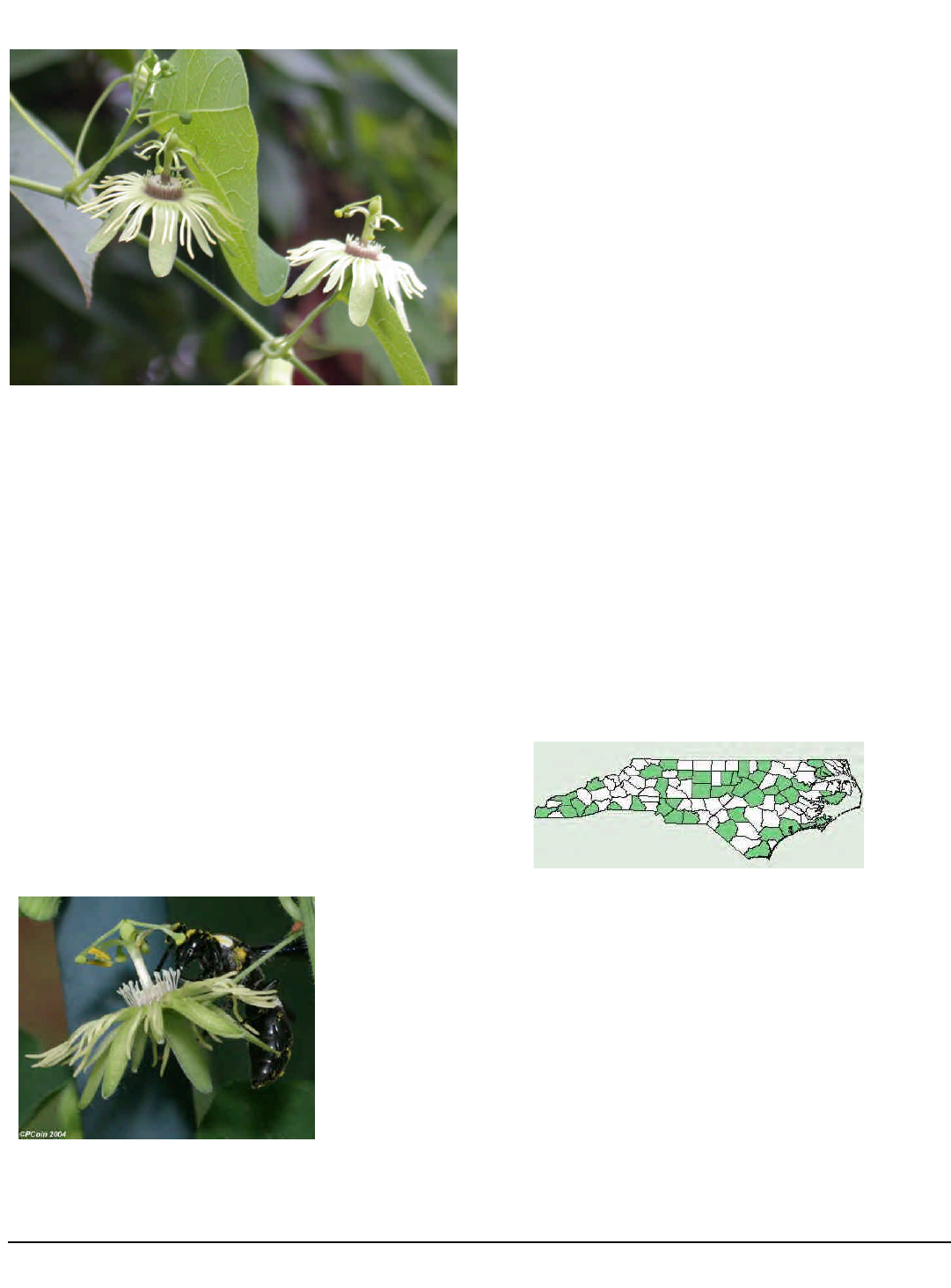
Page
9
Native Plant News
September/October 2006
Passiflora lutea
L.
Yellow passionflower
A
ttracted first by the delicate chartreuse foliage on the
vine clambering up through the tall shrubs in the parking lot
of a shop on a busy thoroughfare, I stepped out of the car for a
closer look. To my delight, this was a flowering vine with
small, greenish
-
yellow flowers that looked like miniature
passionflower blooms. Indeed, they are. This is the
Passiflora lutea
which along with
P. incarnata
are the only
two Passifloras native to North America out of the more than
500 species worldwide.
P. lutea
flowers are only one
-
half to three
-
quarters of an inch
across, often growing two in the axils, and have all the
characteristics of its’ gaudier and coarser cousin
, P.
incarnata. P. lutea
climbs with the aid of its aerial roots,
which are ti
ghtly wound tendrils that grab hold with a fierce
tenacity. Unlike
P. incarnata
, the fruits of the yellow
passionflower are quit
e small, turning from green to a purple
-
black, at which time they are quickly consumed by birds.
Besides the attractive chartr
euse color, the leaves of
P. lutea
are smaller and less deeply lobed than
P. incarnata
. Young
leaves sometimes have a silvery m
ottling.
The fragrant flowers of yellow passionflower,as is true with
most
passionflowers, are
uniquely
constructed to
maximize
the
chances for
pollination. P.
Coin
i
of Durham
snapped this photo
in 2004 of a
Mason wasp consuming nectar from the flow
er. While he is
busy, pollen from the anthers, at the ends of filaments arching
out from the top of the column called an androg
ynophore
ii
,
coats the back of the wasp. The stigmas, at the end of the
styles also arching out and above the sepals and petals from
the and
rogynophore, are perfectly positioned to receive pollen,
from the same flower or others that the wasp has visited.
There are rep
orts of other short
-
tongued bees
iii
and wasps
visiting
P. lutea
, the most efficient of which are those whose
size assures good
pollen collection and delivery.
Butterflies, especially the Gulf Fritillary, are common visitors
as well, but for a differen
t reason.
P. lutea
is a host plant for
the butterfly, which lays its eggs on the back of the leaves.
Triad Chapter member, and
butterfly expert, Dennis Burnette
is watching the plants for additional butterfly visitors.
Though some sources report
P. lute
a
as rare, it is found all
across the Mid Atlantic and southeastern states. In North
Carolina, it is reported in 42 counties
iv
, from the coast to the
far western tip of the state (those counties shaded in green
have reported occurrences of
P. lutea
). It
may be uncommon
in some areas, but more likely the plant is simply overlooked.
A cutting recently brought to the Triad Chapte
r’s Plant Study
group elicited a fair amount of excitement among members
who had not seen it before. It blooms and sets seed in
the
hottest part of the summer. By early fall, the leaves turn
yellow and drop, the vine dying to the ground for the winter.
Propagation can be accomplished from stem cuttings (as long
as the stem is solid rather than hollow, as sometimes happens
with o
lder passifloras of some species), root division or seeds.
The purple juice of the fruits of
P. lutea
, which stains as
surely a
s pokeberries, keeps the seeds viable and may play a
role in leaching out abscisic acid, a hormone that induces
dormancy. Seed
that is allowed to dry may be difficult to
germinate, so is better kept with a little moist sand or peat in
the refrigerator unt
il you are ready to sow. Soaking the seeds
for 24 to 48 hours to leach out the abscisic acid may also
hasten germination.
Fina
lly, as is the custom when discussing passionflower, a
word about the name is in order. In the 17th century Giacomo
Bosio, a ch
urchman and historian working in Rome,
interpreted passiflora drawings sent by Spanish priests in
South America
v
. The early Ital
ian name for the species was
fior della passione
for the fancied resemblance of the flower
parts to elements of the crucifixion
of Jesus .
In other cultures there is no such association
—
in Japan,
passiflora species are known as “clock plants.”
vi
Linna
eus
classified the plants in 1745, thus yellow passionflower is
properly called
Passiflora lutea
L.
K. Schlosser
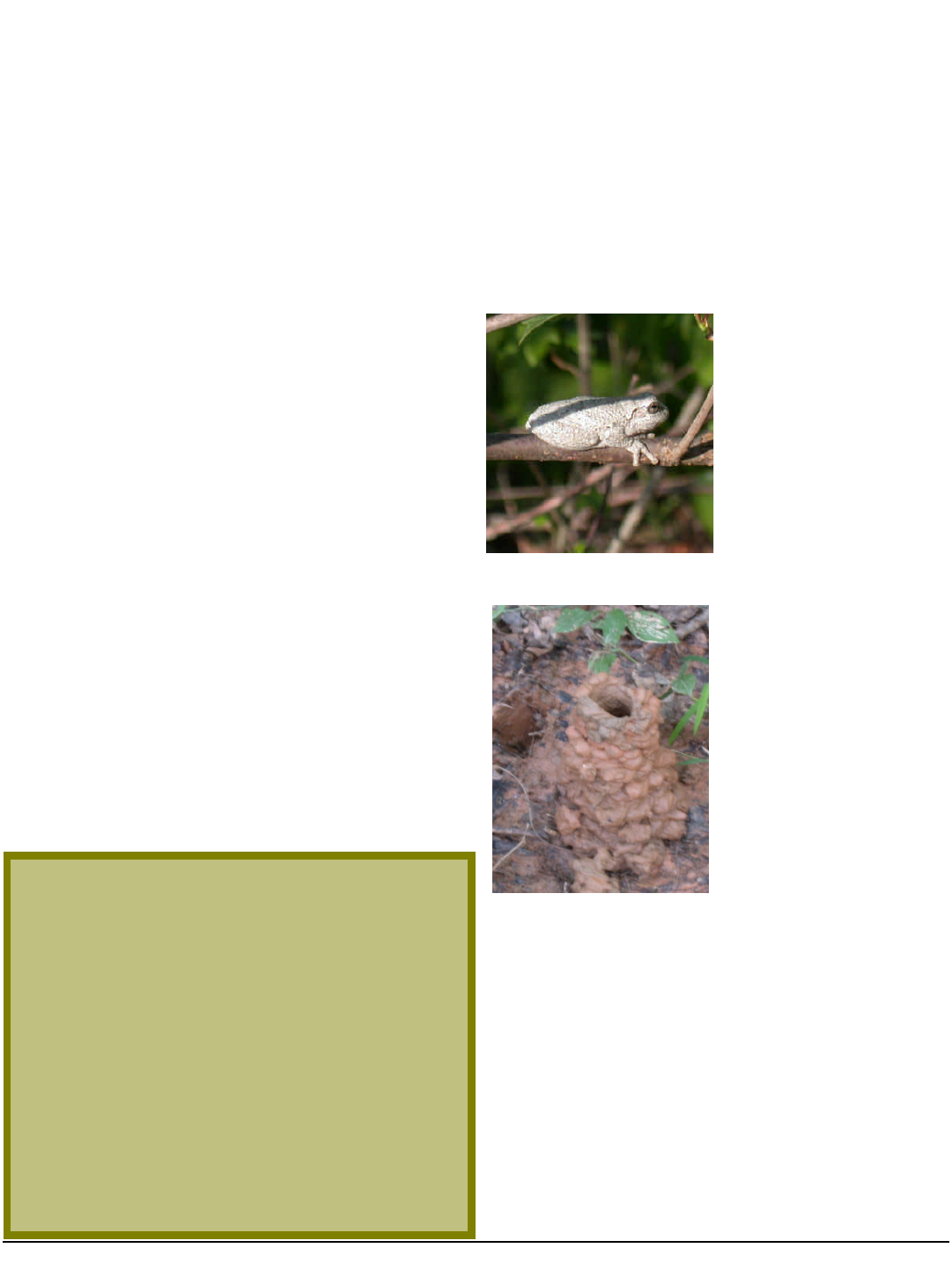
Page
10
Native Plant News
Passiflora lutea
is an attractive plant to train up a trellis or
through shrubs. The do well in most well
-
drained soils, lots
of
light, and moderate moisture. If you grow them in your garden,
keep them where you can watch them for their dainty flowers,
light fragrance, and for the bees, birds, and butterflies they will
attract.
Katherine Schlosser
I
P. Coin, BugGuide http://
bugguide.net/node/view/5453 .
ii
A support formed by the fusion of filaments and styles. In the
passionflower, these parts sepa
rate again at the top of the
column. Radford, Ahles, Bell.
Manual of Vascular Flora of the
Carolinas
. (UNC Press, Chapel Hil
l. 1968) P. 734.
iii
Bees:
Anthemurgis passiflorae, Lasioglossum pruinosus,
Lasioglossum versatus, Colletes latitarsis.
Wasps:
Anacrabo
ocellatus, Eumenes fraterna
. From Insect Visitors of Illinois
Wildflowers,
http://www.shout.net/~jhilty/plants/cream_
passion.htm
iv
Map from Plants Database, www.usda.plants.gov.
v
Felter, M.D., Harvey and John U. Lloyd,
King’s American
Dispensary.
1898. Accessed from Henriette’s Herbal Homepage,
http://www.henriettesherbal.com
vi
Passiflora Online, History. ht
tp://www.passionflow.co.uk
Passiflora lutea
continued
In the Garden and Woods…..
Answers to the ginger question in the last newsletter:
1.
Hexastylis arifolia
2.
H. virginica
3.
Asarum canadense.
When walking through the
woods in search of a
particular plant, we usually
have our heads down. Th
at
means we miss a lot at eye
-
level and above. This little
fellow was on a slender
branch above a swampy
area. Know his name?
This one you do see with your
head bent. While walking
through a patch of skunk
cabbage, I saw 20 or more of
these. The
y stand about 6
–
7 inches tall and the opening
is 1 1/2 to 2 inches wide.
Who lives here?
Answers on page 20 (16 for
print version).
Send a gift membership to the North
Carolina Native Plant Society
….celebrate a birthday
...remember an anniversary
...honor so
meone special
Mail $25.00 to Hugh Partridge, Treasurer, 736
Linda Court, Cary, NC 27513.
Be sure to include
the recipient’s n
ame, address, phone, and email.
We will send a card announcing your gift, and send you
an acknowledgment.
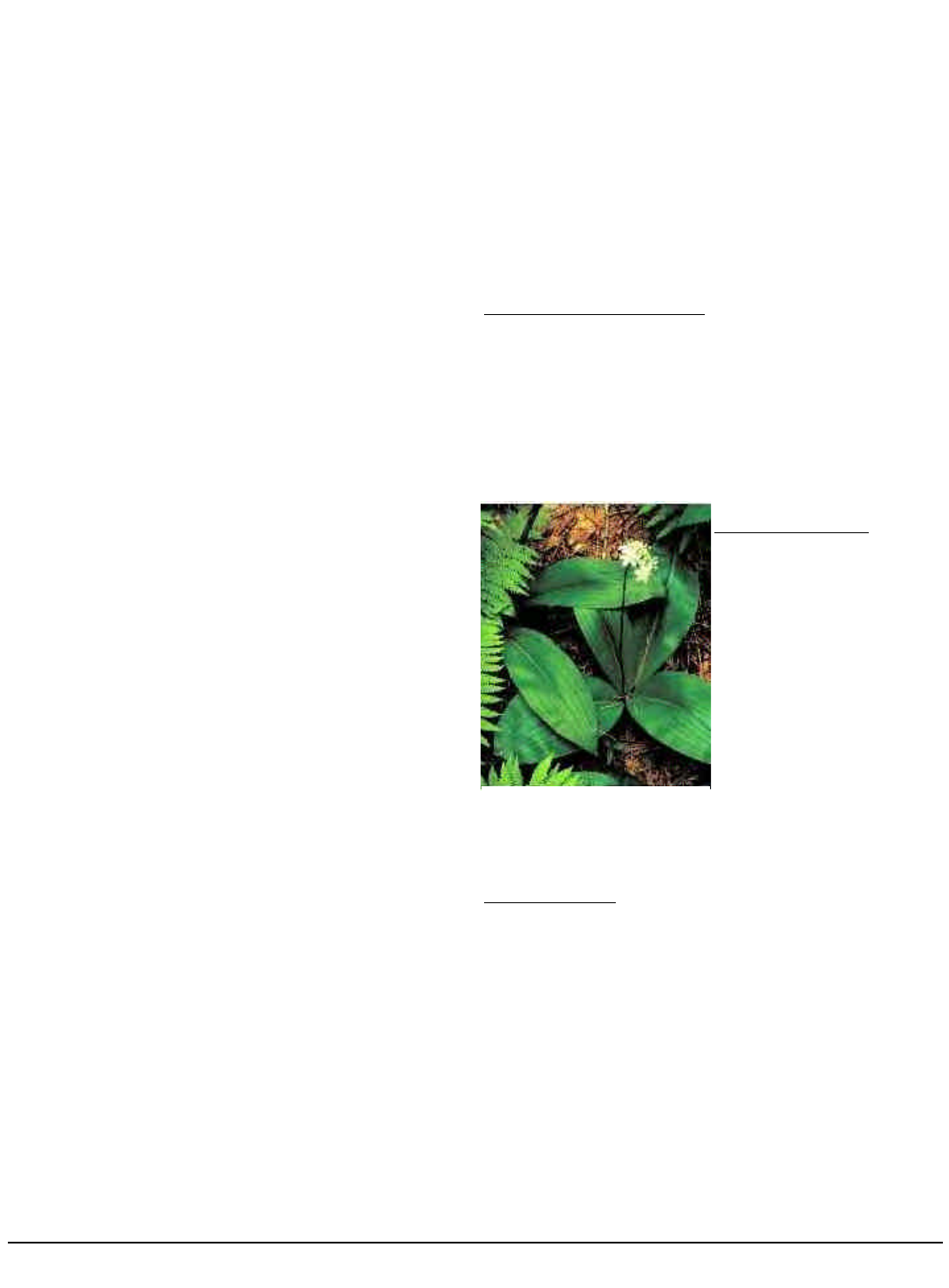
Page
11
Native Plant News
September/October 2006
T
his plant looks similar only different,” said one member
(who knows who they are) as we hiked up the trail to the
Worlds’ Edge. Actually it was a more profound statement than
he perhaps realized, as the sites we visited in the Hickorynut
Gorge were similar to many mountain areas only with remar
k-
able differences.
Geology is what makes it unique. The trip information stated
that these mountains are composed of garnet
-
mica schist, e
x-
foliated granite, granitic gneiss, and amphibolites that produce
rock outcrops. Amphibolites are a metamorphic rock consis
t-
ing of hornblende (minerals of granite and other igneous
rocks) and feldspars with little or no quartz. Small flakes of
black an
d white give it a salt
-
and
-
pepper appearance.
This landscape on the edge of the piedmont features fissure
caves, bluffs and cli
ffs, slopes, coves, rivers and waterfalls
ranging from 1000 to 3000 feet in elevation. This gorge differs
from other escarpment gorges of the Blue Ridge in its abu
n-
dance of calcium, magnesium and iron producing more basic
soils.
The large group of participants was divided to visit each sit
e
each day. My group went to The Nature Conservancy’s Bat
Cave Preserve on Saturday. Clint Calhoun with The Nature Co
n-
servancy shared his local knowledge of the site. Once we
crossed the footbridge over the Broad River we entered into
another wor
ld. The mile hike began in a mature cove hardwood
forest and became a steeper climb through rocky outcrops up
to the caves. The
multi
-
chambered Little Bat Cave and Big Bat
Cave with a mile of passage form the largest fissure cave in
the U.S. Fissure caves
form by cracking rocks, whereas talus
caves form when rocks fall on other rocks. There are five sp
e-
cies of bats here including the reestablished Indiana bat. The
eastern pipistrel stays in the cave in warm weather while other
species go into the trees.
The reward for our climb was feeling the refreshing, cool air by
the cave blowholes. The grotto alu
mroot (
Heuchera parviflora
)
requires very little rainfall to grow under dry rock ledges.
Blee
d
ing heart (
Dicentra eximia
) blooms nearly all year due to
warmth by the cave. Those knowledgeable about amphibians
pointed out a crevice salamander sunning on the rocks, han
d-
some with red markings on its back. Several mountain dusky
salamanders were found under rocks along the path. The
slimly salaman
der is endemic here in rock crevices.
The cove hardwood, hemlock and chestnut oak forests harbor
threatened or endangered plants such as the largest popul
a-
tion of broadleaf coreopsis (
Coreopsis latifolia)
and Carey’s
saxifrage (
Saxifraga careyana
). An abundance of spring
wil
d
flowers grow beneath a canopy of Canada and Carolina
hemlock, basswood, tulip poplar, beech and oaks with u
m-
brella (
Magnolia fraseri
) and cucumber trees (
M. acum
i-
nata
). Noteworthy was hairy mock orange (
Philadelphus
hirsutus
), rare on calcareous rocks and green violet
(
Hybanthus concolor
)
that grows only on basic soils. Here
are some additional plants from my notes.
Shrubs, small trees and vines:
Sweet shrub (
Cal
ycanthus floridus
), wild yam (
Dioscorea
villosa
),
silverbell (
Halesia carolina
), smooth hydrangea (
Hydrangea
arborescens
), spice
bush (
Lindera benzoin
), mock orange
(
Philadelphus inodorous
), rosebay (
Rhododendron max
i-
mum
), wineberry (
Rubus phoenicolasius
), bladdernut
(
Staphylea trifolia
), maple
-
leaved virburnum (
Viburnum
acerifolium
)
Lilies,
irises, orchids:
Speckled wood lily
(
Clintonia umbellulata
), ye
l-
low mandarin (
Disporum
lanug
i
nosum
), dwarf
crested iris (
Iris cristata
),
showy orchid (
Orchis spect
a-
bilis
),
Solomon’s seal
(
Polygonatum biflorum, P.
pubescens
), Sol
o
mon’s
plume, false Solomon’s seal
(
Smilacina racemosa
),
Catesby’s trillium (
Trillium
cate
s
baei
), sweet Betsy (
T.
c
u
ne
a
tum
), southern nodding trillium (
T. rugellii
)
Other wild flowers
:
Baneberry, doll’s eyes (
Actaea pachypoda
), columbine
(
Aquilegia canadensis
), rock cress (
Arabis laevigata
), wild
ginger (
Asarum canadense
), false goatsbeard (
Astilbe bite
r-
nata
), Indian plantain (
Arnoglossum muhlenbergii
=
Cacalia
),
blue cohosh (
Caulophyllum thalictroides
), black cohosh
(
Actea racemos
a
), collinsonia (Collinsonia canadensis),
Robin’s plantain (
Erigeron strigosus
), galax (
Galax aphylla
),
liverleaf (
Hepatica acutiloba
), rock alumroot (
Heuchera vi
l-
losa),
purple bluet (
Houstonia purpurea
), waterleaf
(
Hydrophyllum canadense
), jewel weed (
Impatiens pallida,
I. capensis
), India
n pipes (
Monotropsis odorata
), anise root,
sweet cicely (
Osmorhiza claytonii
), ginseng (
Panax quinqu
e-
folium
), bloodroot (
Sanguinaria canadensis
), Canada violet
(
Viola canadensis
), sweet white violet (
V. blanda
)
Highlights of the Spring Trip to Hickorynut Gorge
Jeannie Kraus
May 19
-
21, 2006
Clintonia umbellata.
From USDA

Page
12
Native Plant News
Ferns:
Maidenhair (
Adiantum pedatum
), walking (
Asplenium
rhiz
o
phyllum
), mountain spleenwort (
A. montanum
), sout
h-
ern lady (
Athryium asplenioides
), silver glade (
A. thelypte
r-
oides
=
Deparia acrostichoides
), fragile (
Cystopteris frag
i-
lis
), hay scented (
Dennstaedtia punctilobula
), marginal
wood (
Dropteris marginalis
), rock cap (Polypodium virgin
i-
a
num)
In the afternoon, some members toured Chimney Rock
Park. The society visited there about 10 years ago. A point
of referenc
e is my photo on my refrigerator by Hickorynut
Falls with my husband, Brian, and son, Forrest, who was
about 5 at the time. Inst
ead I chose to walk the River Walk
Trail, an innovative way for people to enjoy Broad River for
a leisurely stroll with paths to
shops and restaurants.
After dinner at the Old Rock Café, Ron Lance, naturalist at
Chimney Rock Park, spoke about the amazing
variety of
native plants in their unique habitats. The plant auction
was a roaring success for scholarship fundraising as well
as new treasures for our gardens.
On Sunday my group hiked up to
Lower Pool Creek Falls along Wolf
Creek at Worlds Edge Mountain.
Parcels owned by Car
o
lina Mou
n-
tain Land Conservancy, The N
a-
ture Conservancy and N.C. Dept.
of Parks & Recreation will co
m-
prise the future Hickorynut Gorge
State Park. Worlds’ Edge drops
dramatically 2200 feet to the
pie
d
mont. This montane oak hic
k-
ory forest is home to the enda
n-
gered white irisette (
Sisyrinchium
dichotomum
) with feat
h
ery nodes
andse. dichotomous branching, pointed out by James
Pad
g
ett, the Southern Piedmont Inventory Biologist. Bear,
deer and squirrels were traditionally hunted here, and it
was logged in th
e 1950s and 60s.
The trail climbed through a canopy of Virginia, shortleaf,
white and loblolly pines, tulip popular, sycamore, sou
r-
wood, red maple, umbrella tree, cherry birch, black gum,
buckeye, basswood, white and green ash, red and white
oaks, and mulberr
y. The rare Georgia hackberry (
Celtis
tenuifolia
) was pointed out growing on rock outcrops. Not
e-
worthy was the ashy hydrangea (
Hydrangea cinerea
) that
prefers calcareous rocks. Leaf undersides are pubescent,
unlike the smoot
h hydrangea (
H. arborescens
). While
Car
o
lina hemlock prefers dry, rocky habitats, Canada he
m-
lock grows in moist coves. Besides the distinction with
Ca
n
ada’s needles being flat in one plane, it also has a
piney scent, whereas Carolina’s has a limey scent. Unfort
u-
nately the hemlock adelgid, introduced from China in the
1920s, affects both species. If hemlock disappears as a
dominant the en
tire ecosystem will change, like the fall of
the American chestnut. A few small chestnuts here give us
hope they will someday re
turn to their former grandeur.
We enjoyed our lunch below the cool spray of the falls
where dwarf dandelion (
Krigia montana
) w
as growing in
rock crevices. The amazing flowers of wild ginger
(
Hexastylis shuttleworthii
) won “oohs and aahs” from ev
e-
r
y
one. The limestone goldenrod (
Solidago sphacelata
)
grows here, an uncommon species growing on calcareous
rock outcrops. Rock cre
ss (
Arabis laevigatus
) and rock
alumroot (
Heuchera villosa
) are fairly common on the ou
t-
crops. Invasives here, such as multiflora rose, mimosa,
princess tree, were removed from Bat Cave. Bittersweet
(
Celastrus orbiculatus
) with its lovely red berries is inv
a-
sive yet prized by wreath and basket makers. The visit e
n-
ticed us to come back to experience the other waterfalls
when it becomes a state park.
Shrubs and small trees:
Sweet shrub (
Cal
ycanthus floridus
), chinquapin (
Castanea
pumila
)
alternate
-
leaved dogwood (
Cornus alternifolia
), persimmon
(
Diospyros virginiana
), strawberry bush (
Euonymus amer
i-
canus
), silverbell (
Halesia carolina
),
witch hazel
(
Hamamelis virginiana
), St. John’s wort (
Hypericum hyper
i-
coides
), St. Andrew’s cross (
H. stragulum
) mountain do
g-
hobble
(Leucothoe fontenesiana
=
axillaris
var.
editorium
),
spicebush (
Lindera benzoin
),
mountain laurel (
Kalmia latifolia
), moc
k orange
(
Philadelphus inodorous
),
rosebay (
Rhododendron maximum
), pink rhododendron
(
R. minus
),
sassafras (
Sassafras albidum
),
dryland blueberry
(
Vaccinium pallidum
=
vacillans
),
maple
-
leaved viburnum (
Viburnum acerifolium
), possum
haw (
V. cassinoides
)
Vin
es:
Hog peanut (
Amphicarpa bracteata
), wild yam (
Dioscorea
villosa
), passion flower (
Passiflora lutea
), poison oak
Hickorynut Gorge report continued….
Celtis tenuifolia
from USDA
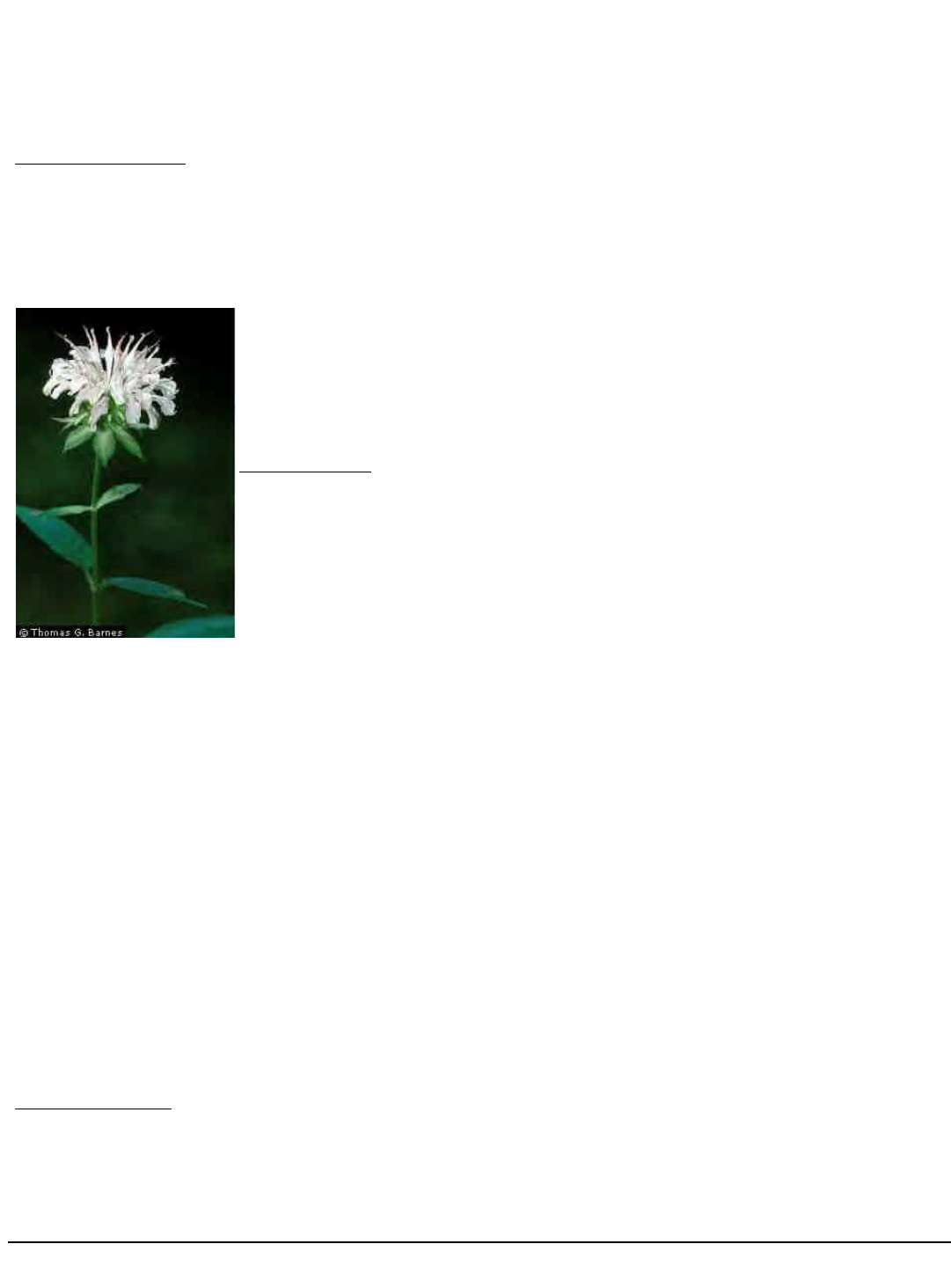
Page
13
Native Plant News
September/October 2006
Hickorynut Gorge report continued...
(
Toxicodendron pubescens
), Biltmore carrionflower (
Smilax
biltmoreana
) on the watch list, common greenbrier (
Smilax
rotundifoli
a
), bristly greenbrier (
Smilax tamnoides
) with zig
-
zag stems, muscadine (Vitis rotundifolia)
ilies, orchids and irises
:
Pink lady’s slipper (
Cypripedium acaule
), rattlesnake pla
n-
tain (
Goodyera repens
), yellow star grass (
Hypoxis hirsuta
),
dwarf crested iris (
Iris cristata
), false lily of the valley
(
Maianthemum canadense
), Indian cucumber root
(
Medeola virginiana
), showy orchid (
Orchis spectabilis
),
blue
-
eyed grass (
Sisyr
inchium
mucronatum), Solomon’s
seal (
Polygonatum pube
s-
cens
), Catesby’s trillium
(
Trillium catesbaei
), sweet
Betsy (
T. cuneatum
), sout
h-
ern nodding trillium (
T. ruge
l-
lii
)
Other wild flowers
:
Agrimony (
Agrimonia roste
l-
lata
), angelica (
Angelica
ven
e
nosa
) very poisonous,
pale Indian plantain
(
Arnoglossum atriplicif
o-
lium
=
Cacalia
), heart
-
leaved
aster (
Aster divaricatus
),
black cohosh (
Actea rac
e-
mosa
), collinsonia
(
Collinsonia canadenesis
),
broadleaf coreopsis (
Coreopsis latifolia
), elephant’s foot
(
Elephantopus tomentosus
), galax (
Galax aphylla
), be
d-
straw (
Galium
sp.), spreading sunflower (
Helianthus divar
i-
catus
), purple bluet (
Houstonia purpurea
), Jack in the pulpit
(
Arisaema triphyllum
), Joe pye weed (
Eupatroium fistul
o-
sum
), whorled loosestrife (
Lysimachia quadifolia
), partridge
berry (
Mitchella repens
), basil bergamot (
Monarda clinop
o-
dia
), jumpseed (Polygonum virginanum=Tovara
virginiana
),
cinquefoil (
Potentilla canadensis
), rattlesnake root, gall of
the earth
(
Prenanthes serpentaria
), Robin’s plantain
(
Erigeron strigosus
), snakeroot (
Sanicula
sp.), Venus loo
k-
ing glass (
Specularia perfoliata
) with “window shade” seed
pods, tall meadowrue (
Thalictrum revolutum
), foamflower
(
Tiarella
cordifolia), sweet white violet (
Viola blanda
), ha
l-
berd
-
leaf violet (
V. hastata
), wood violet (
V. palmata
), round
-
leaf yellow violet (
V. rotundifolia
), yellow root (
Xanthorhiza
simplicissima
)
Ferns and fern allies:
Running cedar (
Diphasiastrum digitatum
=
Lycopodium fl
a-
belliforme
), cut
-
leaf grape (
Botrychium dissectum
), hay
scented (
Dennstaedtia punctilobula
), royal and cinnamon
(
Osmunda regalis
var.
spectabilis
,
O. cinnamomea
), broad
beech (
Phegopteris hexagonoptera
=
Thelypteris
), Christmas
(
Polystichum acrostichoides
), New York (
Dryopteris noveb
o-
racensis
)
Those who delight themselves with birds weren’t disa
p-
pointed as it was the height of mating season. Singing wa
r-
blers included hooded, prothonotary, black
-
throated green,
black and white, worm eating and pine. It was quite a treat
to see a
black and white warbler nest and hatchling on the
ground by the trail. We also enjoyed a scarlet tanager (bright
red against the
greenery), yellow
-
shafted flicker, pileated
and downy woodpeckers, phoebe, ovenbird, cardinal, red
-
eyed and solitary vireos (bl
ue
-
headed), robin, wood thrush,
yellow
-
billed cuckoo, goldfinch, cedar waxwing, kingfisher,
and bluebirds.
Luann Bridle told us
to look for butterflies visiting flowers or
“puddling” along the dirt road at Worlds’ Edge: spring az
u-
res, spicebush and eastern tiger swallowtails, silver
-
spotted
and fiery skippers, and juvenal’s dusky wing. Other critters
seen
by the group included a brown water snake, black rat
snake, green frog, crayfish and many types of mushrooms.
A lasting memory
is Alice Zawadzki’s cabin that served for
socializing and breakfast gatherings to nearby participants
like Charlotte Patterson and myself. Her porch had a wo
n-
derful, soothing view of the river and Chimney Rock beyond.
I can still picture Emily Allen in her favorite spot in the roc
k-
ing chair! One morning we were treated to the sight of a f
e-
male wood duck with seven babies trying to cross the swift
-
flowing river. One little straggler had a difficult time keeping
up a
nd was almost left behind. We all cheered when he
made it across. And here’s a cheer to the organizers of a
marvelous weekend!
Jeannie Kraus
Monarda clinopodia
.
From USDA
Plants Database.
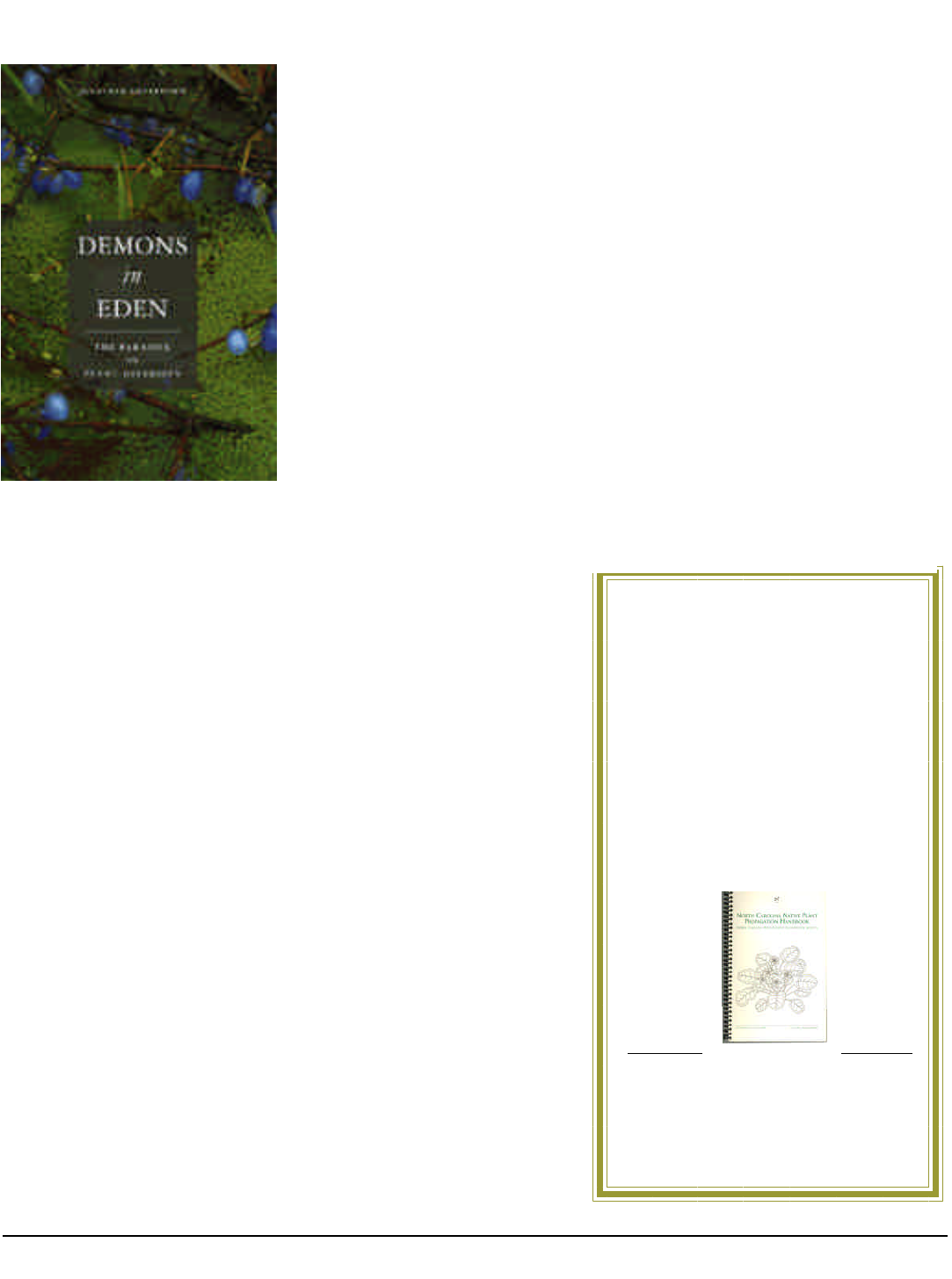
Page
14
Native Plant News
N
ORTH
C
AROLINA
N
ATIVE
P
LANT
P
ROPAGATION
H
ANDBOOK
Available to NCWFPS members for
$13.00 each ($18.00 by mail)*
Regular retail
price: $15.00 ($20.00 by
mail)*
Wholesale price: $10.00 (minimum pu
r-
chase: 5 copies)
(wholesaler responsible for collecting and
paying taxes)
Send your
orders to:
Marlene Kinney
4900 Rich
land Drive
Raleigh, NC 27612
-
3522
*Includes North Carolina taxes.
Book Review
Demons In Eden
S
ilvertown, Jonathan
Demons in Eden
:
The
Paradox of Plant Dive
r-
sity
.
192 p., 8 color plates.
5
-
1/2 x 8
-
1/2 2005
Cloth $25.00 0
-
226
-
75771
-
4 Fall 2005
University of Chicago
Press
A
t
the heart of evolution lies a bewildering paradox.
Natural selection favors above all the individual that leaves
the most offspring
—
a superorganism of sorts that Jonathan
Silvertown here calls the "Darwinian demon." But if such a
demon existed, this highly successful organism would pop
u-
late the entire world with its own kind, beating out other sp
e-
cies and eventually extinguishing biodiversity as we know it.
Why then, if evolution favors this demon, is the world filled
with so many different life forms? What keeps this Darwinian
demon in check? If humankind is now the greatest threat to
biodiversity on the planet, have
we
become the Darwinian
demon?
Demons in Eden
considers these questions using the latest
scientific discoveries from the plant world. Readers join Si
l-
vertown as he explores the astonishing diversity of plant life
in regions as spectacular as the verdant climes of Japan, the
lush grounds of the Royal Botanical Gardens at Kew, the
sha
l
low wetlands and teeming freshwaters of Florida, the
tropical rainforests of southeast Mexico, and the Canary I
s-
lands archipelago, whose evolutionary novelties
—
and exotic
plant life
—
have earned it the sobriquet "the Galapagos of bo
t-
any." Along the way, Silvertown looks closely at the evolution
of plant diversity in these locales and explains why such var
i-
ety persists in light of ecological patterns and evolutionary
processes. In novel and useful ways, he also investigates the
current state of plant diversity on the planet to show the ever
-
challenging threats posed by invasive species and humans.
Bringing the secret life of plants into more colorful and vivid
focus than ever before,
Demons in Eden
is an empathic and
impassioned exploration of modern plant ecology that u
n-
locks evolutionary mysteries of the natural world.
Submited by: Misty Franklin (NCNPS Board member and
Triangle Chapter member)
Excerpt available at:
http://www.press.uchicago.
edu/cgi
-
bin/hfs.
cgi/00/159405.ctl
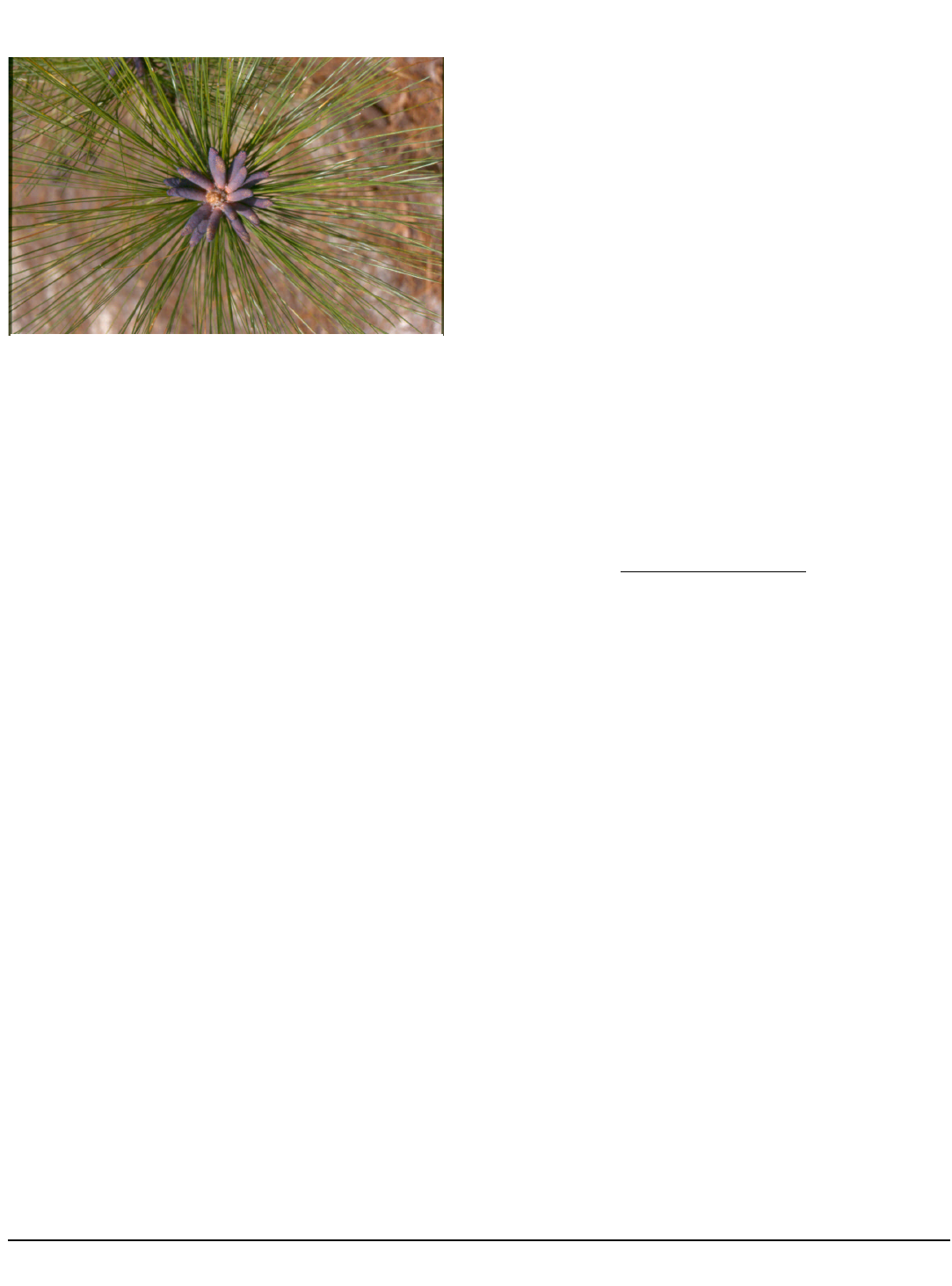
Page
15
Native Plant News
September/October 2006
T
he North Carolina State University College of Agricu
l-
ture and Life Sciences (CALS) and the NCSU Libraries have
formed a partnership to plan and create an exhibit and pe
r-
manent archive of materials related to the Big Savannah
and the B. W. Wells Savannah in Pender County, North
Carolina. The exhibit, anticipated to open in early 2007, will
showcase the opening of a new, museum
-
quality exhibit
gallery being created as part of a major renovation to D. H.
Hill Library. The exhibit will emphasize the beauty and si
g-
nificance of B. W. Wells’ own photographs, along with co
n-
temporary images of the magnificent variety of plants at
the Savannah. It will also tell Wells’ story and recognize his
ongoing legacy. As Exhibits Librarian in the Special Colle
c-
tions Research Center (SCRC) of the Library, I am tasked
with developing the content for display in the exhibition ga
l-
lery.
As I am sure you are familiar, Dr. Wells was extremely a
c-
tive in the early years of the North Carolina Wildflower
Pre
s
ervation Society. In the SCRC collections we have
many society newsletters from 1951
-
1972. I am quite i
m-
pressed with the work your group was doing at that time,
and the role that Dr. Wells played in the society. Often
times Dr. Well
s spoke to the society about the flora of
North Carolina, and the importance of saving it. Especially
poignant was his lecture r
eprinted in the October 1967
newsletter where he talks about his initial discovery of the
Big Savannah of Pender County and lame
nts its eventual
loss.
While these newsletters are wonderful artifacts to display
in their own right, I was wondering if you k
now of anyone in
your society who may have photographs of Dr. Wells
spea
k
ing to the society or giving one of his famous outdoor
lectures. Other documents or artifacts related to Dr. Wells
News from around the state…...
would also be of interest.
Thank you in advance for any assistance you may be able
to provide.
Kevin Schlesier
--
Kevin P
. Schlesier
Exhibits and Outreach Librarian
Special Collections Research Center North Carolina State
University Libraries 2205
Hillsborough Street Campus Box
7111 Raleigh, NC 27695
-
7111
919
-
513
-
8087 (phone)
L
AND
FOR
T
OM
ORROW
A
t the end of the short session, the General Assembly
rat
i
fied a bill to convene the Land and Water Conservation
Study Commission. The commission, appointed by the Go
v-
ernor, Senate President Pro Tempore, and the Speaker of
the State House, will examine the best mode of financing
the Land for Tomorrow program.
The Commission will hold three public meetings across the
state as 2007 approaches. Land for Tomorrow will publ
i-
cize those meetings dates and times when they are esta
b-
lished.
The Commission will report on their findings to the General
Assembly by February 1, 2007. The bill has been sent to
the Governor for approval.
Sign up for electronic updates at:
http://landfortomorrow.org/
Long
-
leaf pine pollen cone. Photo taken at
Pixidanthera brevifolia
site in
Pender County.

Page
16
Native Plant News
NatureServe Ranks Impacts of Exotic Plants
H
ow can you tell which exotic plants pose the most
serious threats to native species and ecosystems?
NatureServe, a non
-
profit conservation organization that
provides scientific information across the US, has
developed an “Invasive Species Assessment Protocol” to
aid in assessing impacts of non
-
native plants found in North
America. Impacts are rated according to their effects on
native plants, animals, and natural communities. After
NatureServe ranks the invasiveness of an exotic species, an
Impact Rank, or “I
-
Rank”, is assigned. These Invasive
Ranks can be found on the NatureServe Explorer website
at: www.natureserve.org/explorer. Natureserve Scientists
hope that hope is that these objective and transparent
assessments will build consensus and encourage action.
The website now includes these "I
-
ranks" for 452 invasive
plant species (among the roughly 3,500 such plants
recorded for the Un
ited States). Additional assessments will
be available in the fall. Individual "I
-
ranks" (high, medium,
low, or insignificant)
are listed with reports about each
species.
You can determine which non
-
native plants in your area
have been ranked "High" imp
act, or which are still
"Unknown”. You can read the entire assessment for any
species and there is a link for providing feedback
that will
help improve the information and refine the I
-
ranks in the
future.
To get all the plants that are non
-
native and occ
ur outside of
cultivation in North Carolina, you can choose North Carolina
on the Location tab and choose the "exotics only" rad
io
button. That search criteria works off the NC Natural
Heritage program's assessment of whether a plant is exotic
in NC. If
the origin/nativity has not yet been assessed, is
lumped with the natives. If you run the search and find
omissions, please cont
act me at [email protected].
Just for fun, I recently looked up the record for English Ivy
(
Hedera helix
), a species t
hat has heavily invaded natural
areas around my home in Chapel Hill. I found it has an I
-
Rank of “High/Medium”. Here is a sample
of some of the
information provided about this species, which also
includes references to scientific articles:
“
Hedera helix
i
s shown to negatively effect forest
biodiversity, especially in the Pacific Northwest. It is also a
popular landscaping plant. T
here is no guaranteed method
for either keeping
H. helix
out of natural areas or removing
it once it has established. As a ground cover, the dense
growth a
nd abundant leaves form a thick canopy just
above the ground that prevents sunlight from reaching
herbs and seedlings. Vines tha
t climb up trees, up to 30m,
slowly kill the tree from the base upwards by enveloping
branches and twigs, blocking sunlight, cau
sing branch and
eventual tree death (Thomas 1980; Swearingen and
Diedrich 2000; Weber 2003). The added weight of vines
also make
s trees susceptible to blowing over during
storms. Can form dense populations that prevent native
plant (both understory and tre
e) establishment,
threatening long
-
term persistence of forests (Bossard et al.
2000; Weber 2003). May replace species used by n
ative
wildlife (Bossard et al. 2000).”
Misty Franklin

Page
17
Native Plant News
September/October 2006
Chimney Rock Park in danger of private development….
In mid
-
July the Morse family put Chimney Rock Park on the market for $55 million. Environmentalists, conservationists,
botanist
s, developers, and local landowners were all surprised at the “For Sale” signs. As you can imagine, interest in the
land is hig
h among developers from near and far. Tom Harville and Dale Suiter put together a letter from the NCNPS
urging our state to pu
rchase the land to include in the new nearby Hickorynut Gorge State Park. The contents of the letter
follow. NCNPS members mig
ht want to consider sending a similar letter of their own. Ed.
Governor Michael F. Easley
Office of the Governor
20301 Mail Service Center
Raleigh, NC 27699
-
0301
Dear Governor Easley:
The N
orth Carolina Native Plant Society is a group of native plant enthusiasts devoted to promoting the
enjoyment and conservation of
native plants and their habitats through education, protection, and propagation
since 1951. We have learned that Chimney Rock P
ark in Rutherford County is currently for sale by the Morse
family, and we are writing to urge you to do everything you can to h
elp protect Chimney Rock Park. Making this
land part of the new Hickorynut Gorge State Park would ensure the protection of this
unique natural area,
conserve habitat for native plants and animals, and make it available for the enjoyment of North Carolinia
ns for
years to come.
According to the NC Natural Heritage Program Rutherford County Inventory, Chimney Rock Park is one of the
most significant natural heritage sites in the State. Natural Heritage Program records indicate that the park
contains at leas
t 16 rare plant species including the federally endangered White Irisette (
Sisyrinchium
dichotomum
) and Rock Gnome Lichen (
Gymno
derma lineare
) and five rare animal species including the state
endangered peregrine falcon (
Falco peregrinus)
and green salaman
der (
Aneides aeneus
).
We love the Chimney Rock area so much that we visited it during our annual spring field trip in 2006.
It would
be a horrible mistake to lose Chimney Rock Park to private developers who may not have the best interests of
the unique
natural communities and rare species in mind.
We appreciate the State's commitment to land conservation through programs such
as the Million Acres
Initiative, One North Carolina Naturally, the Land for Tomorrow coalition, and the Natural Heritage Trust F
und,
and we encourage you and the staff of North Carolina State Parks to continue to work toward protecting
Chimney Rock Park as
one of North Carolina's unique natural treasures.
Sincerely,
Tom Harville
President
cc:
Bill Ross, Secretary, N.C. Departmen
t of Environment and Natural Resources, 1601 MSC, Raleigh, NC
27699
-
1601
Lewis Ledford, Director, N.C. Division of Parks and
Recreation, 1615 MSC, Raleigh, NC 27699
-
1615
Lisa Riegel, Executive Director, N.C. Natural Heritage Trust Fund, 1601 MSC, Ralei
gh, NC 27699
-
1601

Page
18
Native Plant News
A new report on gene flow from experimental GM field trials
in the US to sexually compatible wild plants, has just been
released
by the Center for Food Safety in Washington, DC.
The report's author is Doug Gurian
-
Sherman, CFS's Senior
Scientist, who was f
ormerly with the U.S. Environmental
Protection Agency, where he was responsible for assessing
human health and environmental ris
ks from transgenic
plants and microorganisms, and for developing
biotechnology policy.
His report concludes that given the lar
ge number of field
trials, some of which are on a massive scale and many of
which contain genes that may spread in wild relative
s,
permanent escape of largely untested experimental genes
is virtually inevitable given USDA's current leaky
confinement requir
ements and inadequate safety testing.
Here's the press statement from CFS
-
www.
centerforfoodsafety.org
-
that accompanies Guri
an
-
Sherman's report.
---
Contaminating the wild?
Press Summary
Before genetically engineered (GE) crops are marketed,
developer
s conduct field trials of these
experimental GE varieties for several years. Field trials
include all outdoor cultivation of
exp
erimental GE crops, and thousands have been planted
across the country since the mid
-
1980's.
Because research on these crops is
incomplete, their risks
are often largely unknown. But a new report, "Contaminating
the Wild?," from the Center for Food Safety
shows that
despite unknown risks, U.S. Department of Agriculture
(USDA) regulations cannot be relied upon to keep
experimental g
enes from escaping from field trial crops into
related wild plants. This process, called "gene flow," occurs
when pollen from ex
perimental crops fertilize wild species
related to crops such as wheat, grapes or carrots.
Experimental genes that make their w
ay into crop wild
relatives may become a permanent part of the
landscape because, unlike most crops, these wild plant
species ca
n grow without cultivation by farmers.
Anyone who has seen fields of Queen Anne's lace (a wild
relative of carrots) can underst
and how
prolific these wild relatives can be. And once they escape
from crops, some of these genes could spread through the
envi
ronment, where they may harm animals and plants.
As noted in a recent critical report by the USDA Inspector
General (IG), for the vast majority of field
trials issued as "notifications," gene confinement
measures are rarely reviewed by
USDA prior to planting.
"Contaminating the Wild?" also shows that risk
assessments are not generally performed, and
where risks
are examined, the process is usually
superficial.
USDA has assured the public that the risks from
experimental genes are insig
nificant because they are
confined to the field trial site. But the many cases of
contamination from GE crops seriously challeng
e this
assertion. Most startling was gene flow from a field trial of
transgenic herbicide
-
tolerant creeping bentgrass that
exceeded the 900 ft USDA
-
accepted separation from wild
relatives by at least 13 miles.
"Contaminating the Wild?" asks whether g
ene flow could
similarly occur from some of the thousands
of previous field trials, and by extension, whether gene flow
may happ
en in the future. The report considers these
questions through a detailed examination of the scientific
literature and data from
previous field trials, and concludes
that untested genes from field trials of crops with wild
relatives may breech their confin
ement and spread in the
environment.
THE REPORT FINDS THAT:
*There have been at least 1710 field trials of 20 types of
crops i
n states where one or more wild relatives grow.
These have included 170 for creeping bentgrass, 332 for
wheat and 107 for rice,
among other crops that have
serious weeds as wild relatives.
*The USDA/APHIS confinenement standards cannot
ensure that permane
nt gene flow will be prevented.
Review of the scientific literature and USDA Environmental
Assessments shows that gene flow can
occur beyond the
confinement distances accepted by USDA.
*Many field trials contain genes that may provide
an advantage t
o wild relatives, and can thereby spread
through the wild population, even if initial gene flow occurs
at low levels. For exampl
e, there have been about 600 field
trials for biotic and abiotic stress resistance genes,
identified by the National Academy of
Sciences as having
properties that may facilitate spreading through wild
relatives.
*As with the escaped creeping bentgrass exa
mple, many
News on genetically modified plants….

Page
19
Native Plant News
September/October 2006
Picture your Ad here !
Tell new customers where you are, what you
offer, and that you support NC native plant
conservation.
·
35
0+ members across North Carolina
·
35 institutions and organizations around the country
·
Membership growing at an average of 50 pe
r year
·
Distribution of extra newsletters free to the public at
lectures and events around the state
Business membership
Ad only
1 newsletter
$50
$30
2 newsletters $65
$50
3 newsletters $75
$65
4 newsletters
$80
$75
and annual journal
Contact Katherine Schlosser for details.
336
-
855
-
8022 or kathys@ncwildflower.
org
field trials are large, often hundreds or thousands of acres,
facilitating gene flow. These large trials produce much more
polle
n than small trials, and can cause more gene flow at
longer distances. There have been 290 field trials of 50 or
more acres for
crops with wild relatives.
*The vast majority of field trials, currently about 95%, are
conducted under simplified notification
s that require no
Environmental Assessment. These notifications require only
that any problems noticed
during the field trials a
re reported to APHIS. But as widely
recognized, without specific testing for
environmental harm, most problems may not be detect
ed.
The risks from gene flow in the future may be even more
troubling as multiple genes, genes with less
predictable consequenc
es, and more powerful genes (for
example designed to kill more types of pests), and new
types of plants such as engineered fores
t trees, are
developed.
USDA is currently revising its regulations of GE crops. This is
an opportunity to strengthen the regula
tion of field trials to
prevent gene flow or harm if gene flow occurs. The report
therefore makes several recommendations for
strengthening confinement requirements and improving risk
assessment. Given the large number of field trials, many of
which cont
ain genes that may spread in wild relatives, and
current leaky confinement requirements, permanent escape
of largely untested ex
perimental genes is virtually inevitable
unless USDA substantially improves its confinement and
safety testing requirements.
Fr
om GM WATCH daily
http://www.gmwatch.org

Page
20
Native Plant News
N
ATIVE
P
LANT
N
EWS
The Newsletter of the North Carolina
Native Plant Society
1402 Bearhollow Road
Greensboro, North Carolina
27410
Answers to In the Garden and Woods:
1.
Hyla versicolor
, gray tree frog. This little fellow was about an inch and a half long.
2. These are crayfish chimneys, made from mudballs.
North Carolina’s Native Plant Society since 1951
More
New Colors
North Carolina Native Plant Society
T
-
Shirts
100% cotton, pre
-
shrunk
Sizes: Small, Medium, Large, X Large, XX Large
Colors:
Pine green, White, Tan
pink, yellow, cranberry, light blue, lilac
$15.00 (+ $3.00 shipping)
Send your order (make checks
to NCNPS):
Katherine Schlosser
1402 Bearhollow Road
Greensboro, NC 27410
Be sure to include color and size preference as well
as your
mailing address and an email or telephone so we can let
Native Plant News
The Newsletter of the North Carolina Native
Plant Society.
Vol 4, Issue 4 Sept/Oct 2006
Distribution: 350
+
We welcome:
Articles, Photographs,Letters to the Editor,
Information on good places to see native plants
Join the Newslett
er Committee
Contact the editor:
Katherine Schlosser
1402 Bearhollow Rd.
Greensboro, NC 27
410
336
-
855
-
8022
Deadline for next issue: Nov. 15, 2006
k
